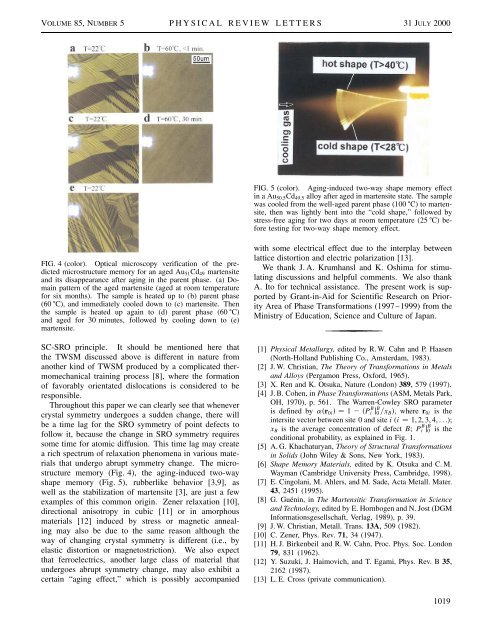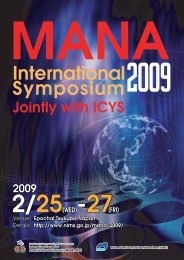Universal Symmetry Property of Point Defects in Crystals
Universal Symmetry Property of Point Defects in Crystals
Universal Symmetry Property of Point Defects in Crystals
You also want an ePaper? Increase the reach of your titles
YUMPU automatically turns print PDFs into web optimized ePapers that Google loves.
VOLUME 85, NUMBER 5 PHYSICAL REVIEW LETTERS 31JULY 2000<br />
FIG. 5 (color). Ag<strong>in</strong>g-<strong>in</strong>duced two-way shape memory effect<br />
<strong>in</strong> a Au 50.5 Cd 49.5 alloy after aged <strong>in</strong> martensite state. The sample<br />
was cooled from the well-aged parent phase (100 ± C) to martensite,<br />
then was lightly bent <strong>in</strong>to the “cold shape,” followed by<br />
stress-free ag<strong>in</strong>g for two days at room temperature (25 ± C) before<br />
test<strong>in</strong>g for two-way shape memory effect.<br />
FIG. 4 (color). Optical microscopy verification <strong>of</strong> the predicted<br />
microstructure memory for an aged Au 51 Cd 49 martensite<br />
and its disappearance after ag<strong>in</strong>g <strong>in</strong> the parent phase. (a) Doma<strong>in</strong><br />
pattern <strong>of</strong> the aged martensite (aged at room temperature<br />
for six months). The sample is heated up to (b) parent phase<br />
(60 ± C), and immediately cooled down to (c) martensite. Then<br />
the sample is heated up aga<strong>in</strong> to (d) parent phase (60 ± C)<br />
and aged for 30 m<strong>in</strong>utes, followed by cool<strong>in</strong>g down to (e)<br />
martensite.<br />
SC-SRO pr<strong>in</strong>ciple. It should be mentioned here that<br />
the TWSM discussed above is different <strong>in</strong> nature from<br />
another k<strong>in</strong>d <strong>of</strong> TWSM produced by a complicated thermomechanical<br />
tra<strong>in</strong><strong>in</strong>g process [8], where the formation<br />
<strong>of</strong> favorably orientated dislocations is considered to be<br />
responsible.<br />
Throughout this paper we can clearly see that whenever<br />
crystal symmetry undergoes a sudden change, there will<br />
be a time lag for the SRO symmetry <strong>of</strong> po<strong>in</strong>t defects to<br />
follow it, because the change <strong>in</strong> SRO symmetry requires<br />
some time for atomic diffusion. This time lag may create<br />
a rich spectrum <strong>of</strong> relaxation phenomena <strong>in</strong> various materials<br />
that undergo abrupt symmetry change. The microstructure<br />
memory (Fig. 4), the ag<strong>in</strong>g-<strong>in</strong>duced two-way<br />
shape memory (Fig. 5), rubberlike behavior [3,9], as<br />
well as the stabilization <strong>of</strong> martensite [3], are just a few<br />
examples <strong>of</strong> this common orig<strong>in</strong>. Zener relaxation [10],<br />
directional anisotropy <strong>in</strong> cubic [11] or <strong>in</strong> amorphous<br />
materials [12] <strong>in</strong>duced by stress or magnetic anneal<strong>in</strong>g<br />
may also be due to the same reason although the<br />
way <strong>of</strong> chang<strong>in</strong>g crystal symmetry is different (i.e., by<br />
elastic distortion or magnetostriction). We also expect<br />
that ferroelectrics, another large class <strong>of</strong> material that<br />
undergoes abrupt symmetry change, may also exhibit a<br />
certa<strong>in</strong> “ag<strong>in</strong>g effect,” which is possibly accompanied<br />
with some electrical effect due to the <strong>in</strong>terplay between<br />
lattice distortion and electric polarization [13].<br />
We thank J. A. Krumhansl and K. Oshima for stimulat<strong>in</strong>g<br />
discussions and helpful comments. We also thank<br />
A. Ito for technical assistance. The present work is supported<br />
by Grant-<strong>in</strong>-Aid for Scientific Research on Priority<br />
Area <strong>of</strong> Phase Transformations (1997–1999) from the<br />
M<strong>in</strong>istry <strong>of</strong> Education, Science and Culture <strong>of</strong> Japan.<br />
[1] Physical Metallurgy, edited by R. W. Cahn and P. Haasen<br />
(North-Holland Publish<strong>in</strong>g Co., Amsterdam, 1983).<br />
[2] J. W. Christian, The Theory <strong>of</strong> Transformations <strong>in</strong> Metals<br />
and Alloys (Pergamon Press, Oxford, 1965).<br />
[3] X. Ren and K. Otsuka, Nature (London) 389, 579 (1997).<br />
[4] J. B. Cohen, <strong>in</strong> Phase Transformations (ASM, Metals Park,<br />
OH, 1970), p. 561. The Warren-Cowley SRO parameter<br />
is def<strong>in</strong>ed by ar 0i 1 2 Pi B j B 0 x B , where r 0i is the<br />
<strong>in</strong>tersite vector between site 0 and site i (i 1, 2, 3, 4, . . .);<br />
x B is the average concentration <strong>of</strong> defect B; Pi B j0<br />
B is the<br />
conditional probability, as expla<strong>in</strong>ed <strong>in</strong> Fig. 1.<br />
[5] A. G. Khachaturyan, Theory <strong>of</strong> Structural Transformations<br />
<strong>in</strong> Solids (John Wiley & Sons, New York, 1983).<br />
[6] Shape Memory Materials, edited by K. Otsuka and C. M.<br />
Wayman (Cambridge University Press, Cambridge, 1998).<br />
[7] E. C<strong>in</strong>golani, M. Ahlers, and M. Sade, Acta Metall. Mater.<br />
43, 2451 (1995).<br />
[8] G. Guén<strong>in</strong>, <strong>in</strong> The Martensitic Transformation <strong>in</strong> Science<br />
and Technology, edited by E. Hornbogen and N. Jost (DGM<br />
Informationsgesellschaft, Verlag, 1989), p. 39.<br />
[9] J. W. Christian, Metall. Trans. 13A, 509 (1982).<br />
[10] C. Zener, Phys. Rev. 71, 34 (1947).<br />
[11] H. J. Birkenbeil and R. W. Cahn, Proc. Phys. Soc. London<br />
79, 831 (1962).<br />
[12] Y. Suzuki, J. Haimovich, and T. Egami, Phys. Rev. B 35,<br />
2162 (1987).<br />
[13] L. E. Cross (private communication).<br />
1019















